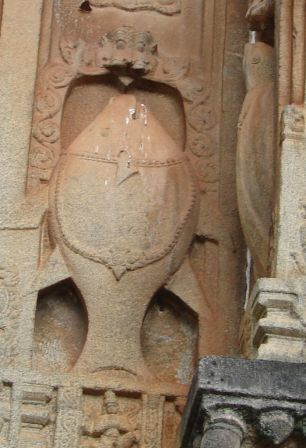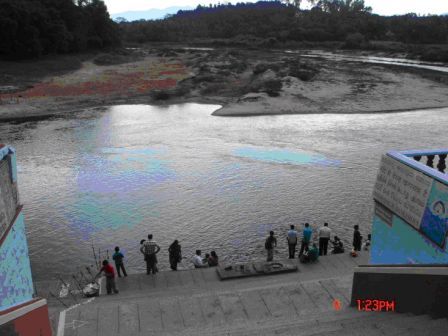
Temple Fish Sanctuaries: Last bastions of native fish and pristine river stretches
Dams in India have converted flowing rivers into reservoirs, which have completely different hydrological character than rivers to which indigenous species have adapted to. Species like Indian Shad (Hilsa hilsa), carps (Labeo calabasu) and catfish (Bagarius bagarius) have been severely affected by these changes. Mahseer or Tor species which swim several kilometres upstream to spawn (breed) in clear water streams or upstream stretches of rivers have been nearly wiped out of our rivers due to several blockages in their spawning route and severe fluctuations in water levels, including no water in summer months! Rivers and reservoirs are now dominated by exotic fish like Tilapia, silver carps, grass carps, African catfishes which tolerate high pollution and static water levels.
A flowing river provides numerous habitats for a variety of fish. Different fish species are found in niches like riffles, runs, deep pools, riparian stretches, floodplains, and estuaries. Fish require flood pulses and drought signals as spawning cues. Temperature and light penetration are also important factors for their sustenance. Dams and barrages affect ALL the above factors, destroying these habitats. On the other hand, dams are stocked with fingerlings of exotic fish species by the Irrigation and Fisheries Departments which are suitable for the static water levels in reservoirs. These exotic fish compete with the local riverine fish species and outnumber them. The tenders issued for fishing in reservoirs are mostly monopolised by powerful external contactors. The inherent equity of riverine fisheries due to the distribution of various fish at different distances has been severely marred through this. Though aquaculture has led to the increase in population of some carp species like Rohu, catla, mrigal, etc, most of the produce is channelized to urban markets and does not contribute to the protein-poor diets of subsistence fisher folk.
At the same time, there are some gems of community conservation which protect not only rare native fish species, but the entire riverine habitats through simple, participatory measures, without any infrastructure development or external funding. Today, these community conserved fish sanctuaries are some of the very few places where we can see native fish and undisturbed river stretches. Most of these are temple sanctuaries, managed by the riparian temples and devotees for centuries. These small temple sanctuaries are nestled along river banks in many states of India. Notably, Karnataka and Uttarakhand still have many such thriving sanctuaries. Dr.Shyama Bhat Kolari, Rtd. Joint Director of Fisheries, Karnataka, has documented 35 such fish sanctuaries in his booklet ‘Development and Management of Freshwater Fish Sanctuaries in India’. This number is likely to increase with more research. Some good news is that new community conserved sanctuaries are being set up in remote areas like Seethanadi by enthusiastic local communities. There is an urgent need to conserve these last bastions from pressures like hydrological fluctuation through dams planned in upstream and large scale pollution through industries.
A snapshot of some of these sanctuaries: Shringeri Fish Sanctuary, Tunga River, Chickmagalur: Shringeri Math, established nearly 1200 years ago on the banks of River Tunga hosts a fish sanctuary teeming with endangered Sahyadri Mahseer fish, Tor khudree. According to a report by IISc (Prof. Gadgil, et al, Status of Karnataka Biodiversity: Aquatic Biodiversity, CES, IISC) the sanctuary supports nearly 38 fish species, with 50% Mahseer.
The sanctuary is managed by Sharada Temple and Shankaracharya Matha. Devotees offer puffed rice to huge congregations of fish in the river and worship them as the ‘Meen avatar’ of Lord Vishnu. Sahyadri Mahseer is known as Bilimeenu in the local language and though it is a prized game and table fish, it is not consumed or caught in the area. Catching these fish is supposed to be a crime against god and a 2 km stretch upstream and downstream of the temple banks is a ‘no fishing zone’. Significantly, no modifications have been made on the river banks by the temple authorities, so that the natural river morphology with sandy banks and islands is maintained. River Tunga is swift and fast flowing in the area, with crystal clear water and very little pollution. This is an ideal habitat for the endangered fish. The area is not yet declared a Fish Sanctuary by the Government of Karnataka and the temple authorities wish that the area should get some formal protection. Of course, such a fish sanctuary should not only protect the fish, but the entire river stretch, with its fast flowing, unpolluted water.

Above: Shringeri Fish Sanctuary Photo: Parineeta Dandekar

Above: Devotees feeding the fishes Photo: Parineeta Dandekar
Chippalgudde Matsya Dhama, Tunga River,Teerthahalli:
In the neighbouring town of Teerthahalli, Chippalgudde Fish Sanctuary is hidden in a tangle of Western Ghat forests, on the banks of Tunga. Chippalgudde hosts a beautiful Siddhivinayak Ganapati Temple and the Bhats who manage this Siddhivinayaka temple trust, also manage the adjacent fish sanctuary, 4 kilometre protected stretch of Tunga river. Devotees buy puffed rice for the fish from the Bhats themselves and one can see confiscated fishnets hanging at their residence. Siddhi Vinayaka Seva Samithi has built platforms on the river bank for feeding the fish. It is a very nondescript infrastructure and does not affect the river morphology. Riparian vegetation is thick on both banks and the locals are replete with morbid stories about the dire outcomes of killing Mahseer from the Tunga waters.

Above: Chippalgudde Matsya Dhama, River Tunga Photo:Parineeta Dandekar

Above: The Siddhivinayaka Temple Photo: Parineeta Dandekar
The tiny stretch protects more than 27 species of fish and significant species include the endangered Mahseer and Puntius pulchellus, the only indigenous herbivorous fish in our country.
Download the entire article:
/articles/temple-fish-sanctuaries-last-bastions-native-fish-and-pristine-river-stretches-report